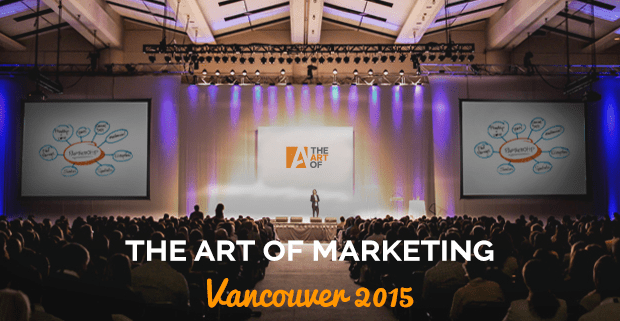
by Sheila Hansen
What do mints, Kodak moments, selfies, Lady Gaga and 2 a.m. decisions have in common? They were all used to illustrate the finer points of messaging at the Art of Marketing conference, April 15 at the Vancouver Convention Centre.
Five marketing mavens/bestselling authors each took to the stage during the daylong event to share their expertise with some 1,200 attendees. We were enlightened, emboldened and entertained. Here is what made me go “hmmm” long after the ballroom lights came on:
Dr. Robert Cialdini
Book: Influence: The Psychology of Persuasion
Quote of the day: “For me, persuasion is the ability to significantly increase the probability of yes to our proposals, our requests, our recommendations without changing the merits of those proposals, requests or recommendations one bit.”
What’s with the mints? Pulling from his scientific research, Dr. Robert Cialdini pointed to the six universal principles of social influence, starting with reciprocation. We are trained from childhood to reciprocate; people say yes to those they owe.
A study found that when a restaurant server included one mint per guest with the bill, tips increased 3.3 per cent; two mints per guest, tips increased 14.1 per cent; when the server included one mint each, left the table, then turned around right away and said “for being such great customers, I’m going to leave you each another mint,” tips jumped 23 per cent.
The task is to find something meaningful, personalized for your customers. Understand your market; give your client something free.
And Dr. Cialdini’s other principles in a nutshell:
- liking: we say yes to those we know and like – identify commonalities
- commitment/consistency: engage the power of a rule (“will you please call if you have to change your reservation?”); be congruent with what you say publicly
- scarcity: people want more of the things there are less of (think Apple product launches)
- authority: people want to follow the lead of experts – reduce uncertainty by showcasing testimonials
- credibility: establish an awareness of your knowledge before trying to influence, via a third party, letter of introduction, LinkedIn; mention a weakness at the beginning of your presentation, then drop your strongest argument – bang! you’ve proven to be an honest broker of information (think L’Oréal: “We’re expensive, but you’re worth it.”).
Nir Eyal
Book: Hooked: How to Build Habit-Forming Products
Quote of the day: “I believe we are on the precipice of an age where we can use habits for good. And I’m not alone because today there is an explosion of companies that are using the psychology of habit design to help people live happier, healthier, more productive, more connected lives.”
What’s with the Kodak moments? Condensing the contents of his 250-page book into 45 minutes, Nir Eyal explained the “hook” pattern of habit-forming products. It’s about connecting a user’s problem to your solution with enough frequency to form a habit.
External triggers cue users to action (“Buy now” link); internal triggers are an association in the user’s mind (when we’re lonely, we visit Facebook; bored, YouTube). Understand your user’s internal triggers (think yesterday’s Kodak moments, today’s Instagram – both provide solutions to fear of losing the moment).
If a user has enough motivation and ability, the trigger succeeds. Action leads to reward, and variability increases action (pulling the arm of a slot machine is the same as scrolling Twitter feed for best tweets). We need to provide a link between the variable reward and internal trigger, to “scratch the itch.”
In the end, while the goal of enterprise is to make a profit, Eyal questioned the morality of manipulation: we have to be careful in what we promote. After all, devices have been called the cigarettes of the 21st century. Let’s find important problems to fix, he said, to help people build more meaningful, productive lives.
Martin Lindstrom
Books: Buyology; Brandsense; Brandwashed
Quote of the day: “Loyalty is not generated based on a Facebook ‘like’ – five seconds. It’s based on goosebumps, which last much longer.”
What’s with the selfies? In his opening video, Martin Lindstrom describes himself as a “compulsive gatherer of clues, a hunter, so to speak, of desire.” Indeed, we are constantly leaving clues behind us.
He then took us on an around-the-world journey, touching down in Europe, Saudi Arabia and North Carolina. Each stop had a story, and each story showed how you can take two or more ordinary things and combine them in a new way to create something new.
- Clues: a shampoo bottle with a small hole had teen girls in Europe spending less time washing their hair each morning but more time taking selfies (an average of 17), to share with friends to make sure clothes were colour coordinated and dresses weren’t duplicated. Result: the world’s first digital dressing room, which lead to a 23 per cent increase in revenue for one of the largest fashion retailers in Europe.
- Clues: plastic-wrapped car seats and remote controls in Saudi Arabia; children playing with fire engines and reading fairy tales about fire – all added up to fear, including about malls catching on fire. Result: a sprawling four-season mall with a fire station at the entrance and rivers running through it, currently being built.
- Clues: customers had fallen into routine at a North Carolina supermarket chain; customer passwords protect dreams and remind of what matters most; we all have two ages (inner and real). Result: storytelling was infused into all aspects of the customer experience, from chicken chandeliers and a beer den to on-the-hour events (chicken dance, cake walk) – sales went up 24 per cent.
It’s when we combine clues in the online world with the offline world, says Lindstrom, that the picture becomes truly fascinating.
Jackie Huba
Book: Monster Loyalty: How Lady Gaga Turns Followers Into Fanatics
Quote of the day: “ The most engaged customers are only about one per cent. It’s a really small number, but they have so much influence in evangelizing a company to other people. That is the power of this one per cent.”
What’s with Lady Gaga? Having studied the mega pop star for five years, Jackie Huba looks beyond the big splashy spectacle of Lady Gaga and sees an amazing loyalty marketer.
What strategies is the singer using that businesses can also use to create their own loyalty?
- Focus on the one per cent of your audience, the super fans, the advocates who absolutely love what you do. They will take time out of their lives to do crazy things in support of a brand – Huba sports a Pittsburgh Steeler ankle tattoo and runs a fan club – yet so many companies ignore them in favour of focusing on new customers.
Do you know who your one percenters are? Do you treat them differently than regular customers?
- Lead with values. Research shows companies that lead with values outperform the market. Connecting with customers on an emotional level pays off (look at the Method line of eco cleaning products). Lady Gaga launched the Born This Way Foundation to help youth live better lives.
What are the values of your company? What are you doing to showcase what you stand for?
- Build community among one percenters. Lady Gaga (a.k.a. Mother Monster) launched littlemonsters.com, where she and her top fans (a.k.a. Little Monsters) connect. Fans have first access to tickets, get to chat with the star and each other.
How are you connecting your one percenters? (Look at car company MINI’s fan-run clubs and Takes the States biannual reunions – that’s some word of mouth).
- Generate something to talk about. Who can forget Lady Gaga’s meat dress? But did you hear about her unisex perfume called Fame? It’s black in the bottle but sprays on clear. (We witness this first-hand as a bottle-welding Huba leaves the stage to spray volunteers, me included.) Fame became the fastest-selling perfume after Chanel No. 5.
What are you doing to stand out to get people talking? Be creative, think differently. Be brave, be bold.
Chip Heath
Books: Made to Stick; Switch; Decisive
Quote of the day: “In a poll of over 2,000 executives, 60 per cent said that bad decisions in their organization were about as frequent as good decisions. That’s a fairly sobering assessment.”
What’s with the 2 a.m. decisions? Chip Heath opens by asking if anyone has woken up at 2 a.m. and made the mistake of trying to make a decision, only to have trouble falling back to sleep? Many hands go up, including mine.
Heath looked at how we can make better and bolder decisions. Sure, you can trust your gut, your intuition, but only after you’ve spent a decade in the field or when feedback is quick and clear. When charting new or unfamiliar territory, Heath turns to his WRAP process:
- Widen your options. Instead of a thumbs up/thumbs down approach, look for a second or third option. The first villain of decision-making is a narrow frame – force yourself to think about other ways of dealing with a problem.
- Reality-test your assumptions. We turn to information that supports our own beliefs – the villain known as confirmation bias. “Ooch before you leap.” Example: physical therapist training involves 100 hours with a trainer to see if that career is right for you. Same goes for the hiring process: interviews are much less predictive than work samples.
- Attain some distance. We agonize over minor decisions almost as much as major ones. Villain: short-term emotion. You could just sleep on it, but this takes time and isn’t a reliable indicator. Try Suzy Welch’s 10-10-10 proposal: think about the implications of your decision 10 minutes, 10 months, 10 years from now.
- Prepare to be wrong. Confidence is the feeling you have before you know all the facts. Villain: overconfidence. You need to set a tripwire early to de-escalate your way to a bad decision. David Lee Roth’s tripwire was a line in Van Halen’s stage set-up contract: there was to be no brown M&Ms in the backstage area. If the band found brown M&Ms, it meant technical safety requirements were also likely overlooked and the venue was not fit for a performance.
In closing, Heath has the audience chanting “no more 2 a.m., no more 2 a.m.” I know I’m not the only one in the room planning on a good’s night sleep.

Sheila Hansen is an award-winning editor and writer based in Vancouver, B.C. Connect with Sheila on LinkedIn and Twitter.